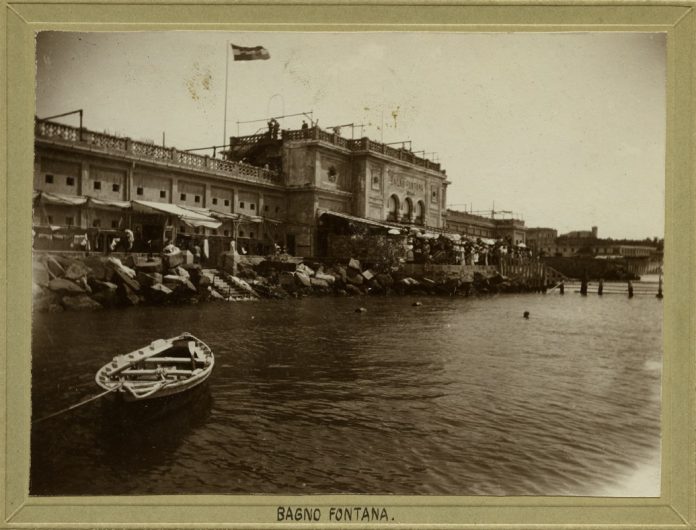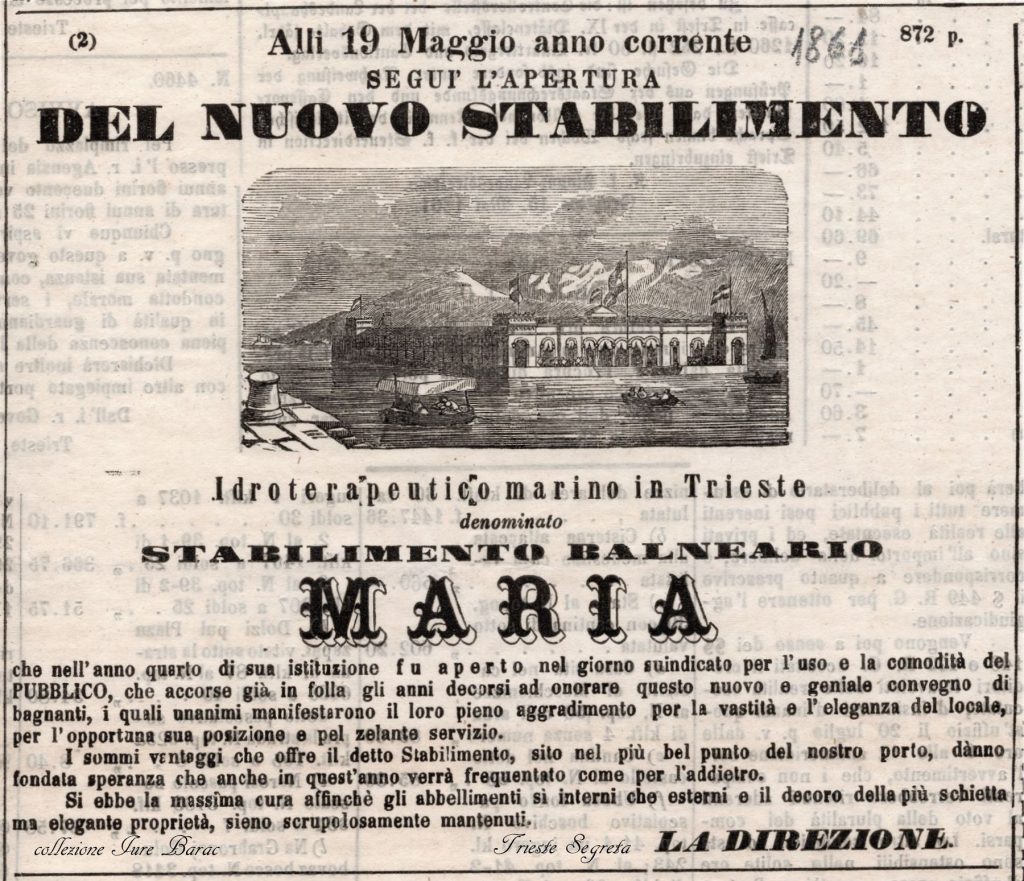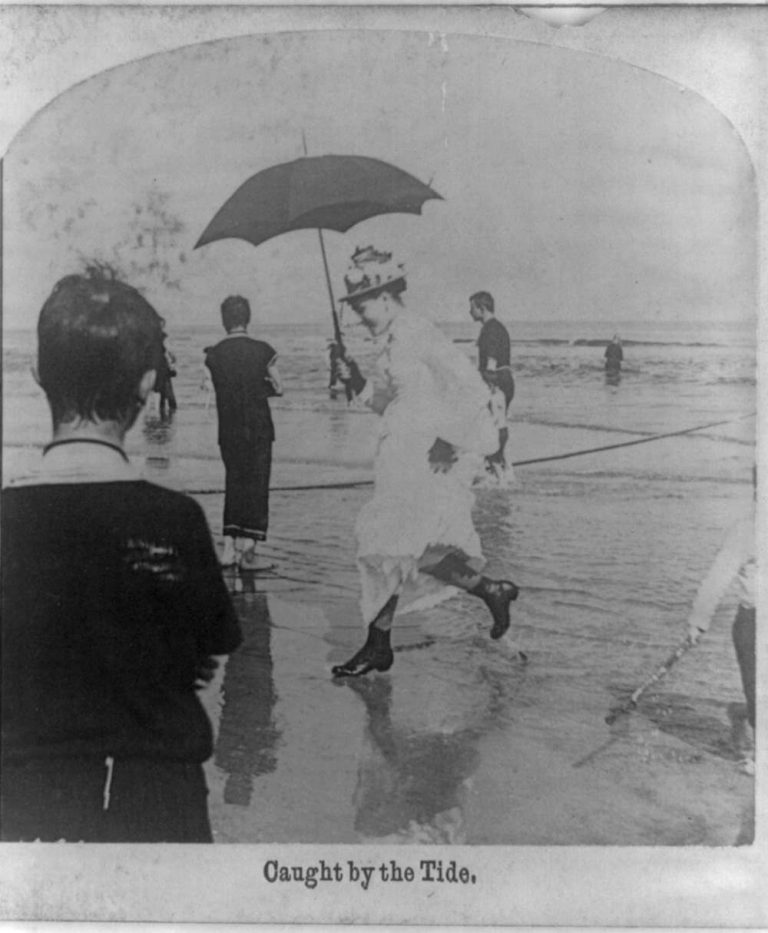by Alessandra Ressa
Although it is quite normal for Triestini to sunbathe in their swimsuits just about anywhere near the sea, visitors new to town may be surprised by the casual indifference of the locals to exposing their barely covered bodies to passersby and cars alike along the busy roads in summer.
Between May and September, it’s “bagno time” for Triestini. However, if you are amused by the amount of people tanning along main roads from Muggia to Barcola, you should probably know that in the good old times, when Trieste was the pulsating heart of Central Europe, people used to sunbathe all along the Rive and next to Piazza Unità, where, in the mid 1800s, the earliest and most exclusive artificial beaches sprang up like mushrooms.

The earliest artificial floating beach resort in Trieste dates back to 1823. It was known as Soglio di Nettuno and was anchored in front of today’s Piazza Venezia (Piazza Giuseppina at the time). People could enjoy its private luxury rafts through a short boat ride or a shaky footbridge. The owner and inventor of this unique floating beach prototype was tradesman Domenico d’Angeli.
To offer an even more exclusive service to its clientele, he built hot and freshwater baths. Soglio di Nettuno also had a café and a restaurant with a smoking room for gentlemen. It was decorated with tall water tanks displaying fish and sea plants from Trieste’s Gulf. Among the celebrities who enjoyed the resort’s mundane atmosphere, was Austrian Emperor Franz I in June 1832.

Around 1832, in front of Piazza Unità (then known as Piazza Grande), another luxury floating beach opened its doors, or rather waters, to Trieste’s high society. It was the Bagno Galleggiante Boscaglia (Floating beach resort Boscaglia), named after its owner. Its wooden structure was anchored in open waters and could be reached by a steamboat.
It could be easily dismantled at the end of summer, stored away and reassembled the following year. For practical purposes, in the years that followed it was conveniently docked in today’s Sacchetta. A few years later it was bought by another businessman, Buchler, who spent a fortune to renovate it. It soon became one of the most popular bagno in Trieste. Later named Galleggiante Nazionale, its fortune ended in June 1911, when an unprecedented storm hit Trieste, destroying baths, boats and buildings along the Rive, and claiming the lives of 27 people.

The popularity of early bagni saw several others open up in Trieste. Among those the Stabilimento Balneare Maria, the most popular of the time. Built in 1857 by Edoardo Strudthoff in occasion of the grand opening of the new Stabilimento Tecnico Triestino shipyard, the new floating structure was entirely made of metal. It was a giant 50 meter wide iron platform placed on big metal pipes which allowed floating and sturdiness at the same time. Wooden cabanas stood all around the structure, and fine furnishing made it the most exclusive beach resort in Trieste. Just like today’s Pedocin beach, one area was reserved to men and another to women and children. There was a shaded hall, a café, a wide terraced area. Swimming lessons were held daily by professional instructors. Its reputation traveled wide and soon well-to-do customers from all over the Austro-Hungarian Empire crowded Bagno Maria for its well-known beneficial sea baths.

Even then, although bathing suits covered women from head to toe, right-thinking Triestini found them scandalous. With their ample beach gowns covering the ankles, women wore wide hats or waxed bonnets decorated with colorful ribbons. Fashion of the time recommended great dome-shaped umbrellas with minutely plated, laced rims, and long gloves up to the elbow never to be removed, ideally made of soft suede or Scotland yarn. This was of course the beach fashion for Trieste’s high society. For middle and working class women, sunbathing was quite a different story.

The overpowering desire to sunbathe (one of the traits of a true Triestino), together with the lack of financial resources to pay for access to one of the exclusive floating baths led many people to crowd the rocky shores of Rive near the Theresian wharf.
Towards the end of the ‘800s that area became a free-entrance municipal beach while next to it, a new, fashionable and more affordable resort opened, Bagno Fontana. Its immediate success was due to the ever growing presence of the emerging and influential middle class, who could reach the premises through a streetcar pulled by horses for the exclusive use of customers. The more mundane atmosphere led to further freedom in women’s beachwear. At the time, Triestine ladies had the reputation of being the most independent and emancipated women of the Empire. And the most scandalous in terms of swimsuits.

Today, of the many city center’s historical beach resorts, only Pedocin and Ausonia survive. Pedocin‘s vintage structure, ongoing separation for men and women and very affordable entrance fees make it one of Triestini’s most beloved destinations in summer, and a must-see spot for visitors.





























